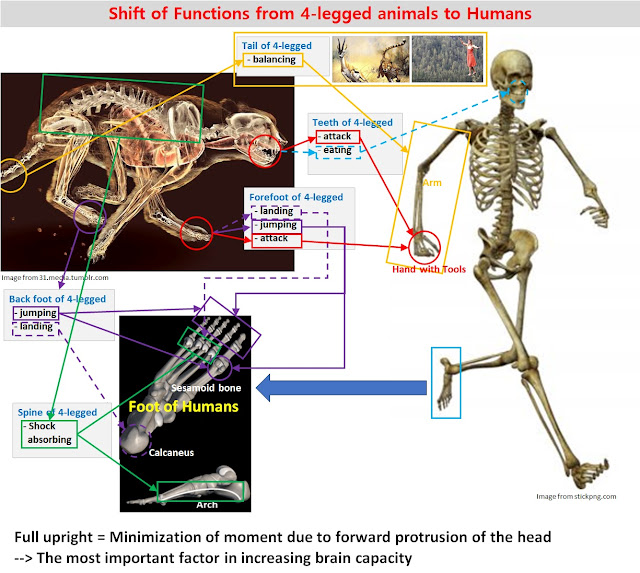1. Interpretation of the function of the main foot bones of humans and chimpanzees
Among the foot bones, the bones to pay attention to are the calcaneus (heel bone) and the 1st metatarsal, and structurally, they have an arch shape that exists in the middle part of the lower foot (see Figures 1 and 2).
.jpg) |
| Figure 1 |
.jpg) |
| Figure 2 |
.jpg) |
| Figure 3 |
I interpret the functions of the main foot bones of humans and chimpanzees as follows.
First, in humans, the calcaneus (heel bone) is the starting point of landing during running activities and plays a role in withstanding the repulsive force generated when a large body load is transmitted to the ground. However, in chimpanzees, the entire hind foot serves this function.
Second, the more the 1st metatarsal spreads laterally across the entire sole, the stronger its role in holding something becomes. Conversely, the smaller the spread or the thicker it is than the other four toes, the stronger its effective function for endurance running where inertial force changes are not severe.
Third, the arch, which is strongly developed in humans and exists in the lower middle of the foot when running, replaces the shock absorbing role of the spine of four-legged mammals.
Fourth, it can be interpreted that the functions of the hind feet, spine, and front feet of four-legged mammals are integrated into the human feet. When running, the landing function of the hind feet of four-legged mammals is handled by the calcaneus (heel bone) of modern humans, which exists at position 1 in Figure 4 below, and the shock absorption function of the spine is handled by the arch shape and position 2. , the function of the forefoot is now handled by the 1st metatarsal and sesamoid bone located in position 3.
.jpg) |
| Figure 4 |
Fifth, the direction of foot bone evolution among modern humans, including chimpanzees and several other species, was in the direction of strengthening the foot bone's function of grasping objects and running for long periods of time.
However, evolution in this direction appears to have occurred through natural selection and/or leaps (mutations) rather than the will of the species. And the results seem to have a direction in which optimal economics is further strengthened in relation to energy use.
2. In Apes, the arms perform the function of the tail in four-legged mammals
Earlier, I said that the functions of the hind feet, spine, and forelimbs of four-legged mammals can be interpreted as integrated into the human foot. So what role can the arms of apes, including humans, play when running? I am interpreting it as follows.
In four-legged mammals, the tail plays a role in controlling the inertial force of the body to prevent the body from derailing due to the inertial force when changing direction quickly and suddenly. The function of the tail is clearly demonstrated in a cheetah chasing its prey at full speed. In apes trying to stand upright, the tail would have been gradually degenerated or mutated because it was located lower on the body and had the effect of reducing the ability to properly control changes in the inertial force of the upper body. On the other hand, in apes that gave up high speed, the arms were able to fully replace the role of controlling the inertial force of the tail in four-legged mammals.
However, evolution in this direction appears to have occurred through natural selection and/or leaps (mutations) rather than the will of the species. And the results seem to have a direction in which optimal economics is further strengthened in relation to energy use.

No comments:
Post a Comment